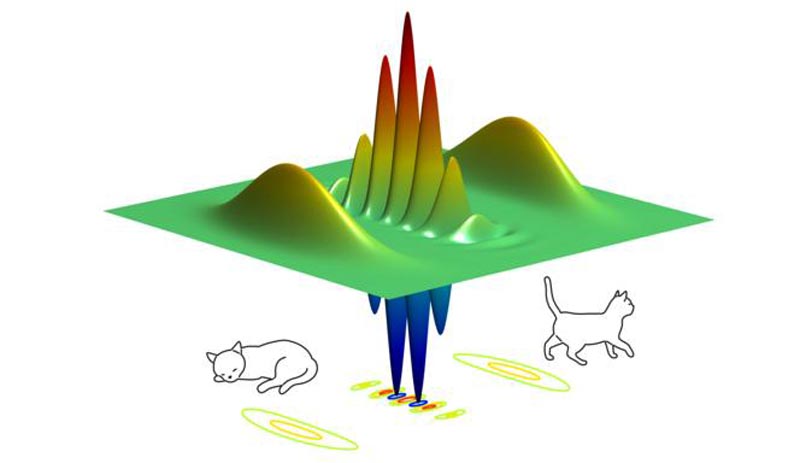

An illustration of Schrödinger’s cat code
Credit: Vincenzo Savona (EPFL)
Quantum computing uses the principles of quantum mechanics to encode and elaborate data, meaning that it could one day solve computational problems that are intractable with current computers. While the latter work with bits, which represent either a 0 or a 1, quantum computers use quantum bits, or qubits – the fundamental units of quantum information.
“With applications ranging from drug discovery to optimization and simulations of complex biological systems and materials, quantum computing has the potential to reshape vast areas of science, industry, and society,” says Professor Vincenzo Savona, director of the Center for Quantum Science and Engineering at EPFL.
Unlike classical bits, qubits can exist in a “superposition” of both 0 and 1 states at the same time. This allows quantum computers to explore multiple solutions simultaneously, which could make them significantly faster in certain computational tasks. However, quantum systems are delicate and susceptible to errors caused by interactions with their environment.
“Developing strategies to either protect or qubits from this or to detect and correct errors once they have occurred is crucial for enabling the development of large-scale, fault-tolerant quantum computers,” says Savona. Together with EPFL physicists Luca Gravina, and Fabrizio Minganti, they have made a significant breakthrough by proposing a “critical Schrödinger cat code” for advanced resilience to errors. The study introduces a novel encoding scheme that could revolutionize the reliability of quantum computers.
What is a “critical Schrödinger cat code”?
In 1935, physicist Erwin Schrödinger proposed a thought experiment as a critique of the prevailing understanding of quantum mechanics at the time – the Copenhagen interpretation. In Schrödinger’s experiment, a cat is placed in a sealed box with a flask of poison and a radioactive source. If a single atom of the radioactive source decays, the radioactivity is detected by a Geiger counter, which then shatters the flask. The poison is released, killing the cat.
According to the Copenhagen view of quantum mechanics, if the atom is initially in superposition, the cat will inherit the same state and find itself in a superposition of alive and dead. “This state represents exactly the notion of a quantum bit, realized at the macroscopic scale,” says Savona.
In past years, scientists have drawn inspiration by Schrödinger’s cat to build an encoding technique called “Schrödinger’s cat code”. Here, the 0 and 1 states of the qubit are encoded onto two opposite phases of an oscillating electromagnetic field in a resonant cavity, similarly to the dead or alive states of the cat.
“Schrödinger cat codes have been realized in the past using two distinct approaches,” explains Savona. “One leverages anharmonic effects in the cavity, the other relying on carefully engineered cavity losses. In our work, we bridged the two by operating in an intermediate regime, combining the best of both worlds. Although previously believed to be unfruitful, this hybrid regime results in enhanced error suppression capabilities.” The core idea is to operate close to the critical point of a phase transition, which is what the ‘critical’ part of the critical cat code refers to.
The critical cat code has an additional advantage: it exhibits exceptional resistance to errors that result from random frequency shifts, which often pose significant challenges to operations involving multiple qubits. This solves a major problem and paves the way to the realization of devices with several mutually interacting qubits – the minimal requirement for building a quantum computer.
“We are taming the quantum cat,” says Savona. “By operating in a hybrid regime, we have developed a system that surpasses its predecessors, which represents a significant leap forward for cat qubits and quantum computing as a whole. The study is a milestone on the road towards building better quantum computers, and showcases EPFL’s dedication in advancing the field of quantum science and unlocking the true potential of quantum technologies.
Reference
Luca Gravina, Fabrizio Minganti, Vincenzo Savona. A critical Schrödinger cat qubit. Physical Review X Quantum 4, 020337. 07 June 2023. DOI: 10.1103/PRXQuantum.4.020337
Journal: PRX Quantum
DOI: 10.1103/PRXQuantum.4.020337
Article Title: Critical Schrödinger Cat Qubit
Article Publication Date: 7-Jun-2023












